Category: Class 12
Simple Harmonic Motion Formulas
Simple Harmonic Motion Formulas: Simple Harmonic Motion (SHM) is a fundamental concept in physics that describes the repetitive back-and-forth motion of an object around an equilibrium position.
Many physical phenomena, from a swinging pendulum to vibrating guitar strings, can be modeled as simple harmonic motion.To analyze and describe this motion, several key formulas come into play. In this article, we will explore these formulas, their significance, and how they help us understand and predict simple harmonic motion.

Simple Harmonic Motion Formulas
1. Displacement (x): The displacement (x) of an object undergoing SHM at any given time is the distance and direction from its equilibrium position.
Formula: x(t) = A * cos(ωt + φ)
- x(t) represents the displacement at time t.
- A is the amplitude, the maximum displacement from the equilibrium position.
- ω (omega) is the angular frequency, which depends on the system’s characteristics.
- φ (phi) is the phase angle, indicating the initial position of the oscillating object.
2. Velocity (v): The velocity of an object in SHM describes how fast it is moving at any point in its oscillation.
Formula: v(t) = -A * ω * sin(ωt + φ)
- v(t) represents the velocity at time t.
- A is the amplitude.
- ω is the angular frequency.
- φ is the phase angle.
3. Acceleration (a): The acceleration of an object undergoing SHM represents its rate of change of velocity and is directed toward the equilibrium position.
Formula: a(t) = -A * ω^2 * cos(ωt + φ)
- a(t) represents the acceleration at time t.
- A is the amplitude.
- ω is the angular frequency.
- φ is the phase angle.
4. Angular Frequency (ω): The angular frequency (ω) is a measure of how quickly an object oscillates in SHM.
Formula: ω = 2πf
- ω is the angular frequency.
- f is the frequency, which represents the number of oscillations per unit time (usually in hertz, Hz).
5. Period (T): The period (T) is the time it takes for one complete oscillation, and it is the inverse of frequency.
Formula: T = 1/f
- T is the period.
- f is the frequency.
6. Frequency (f): The frequency (f) measures the number of oscillations per unit time.
Formula: f = 1/T
- f is the frequency.
- T is the period.
These formulas provide a comprehensive framework for analyzing and understanding simple harmonic motion. They allow us to calculate key parameters such as displacement, velocity, and acceleration at any given time, helping scientists and engineers model and predict the behavior of systems exhibiting SHM.
Applications of Simple Harmonic Motion Formulas:
- Mechanical Systems: Formulas for Simple Harmonic Motion (SHM) find application in the examination of the movement of pendulums, vibrating springs, and oscillating objects within mechanical systems.
- Electromagnetic Waves: In physics, the equations governing electromagnetic waves, such as light, can be described using SHM principles.
- Sound Waves: Vibrating objects, like guitar strings or tuning forks, produce sound waves that can be analyzed using SHM formulas.
- Quantum Mechanics: SHM concepts and equations are used in quantum mechanics to describe the behavior of particles within potential wells.
In conclusion, simple harmonic motion formulas provide a powerful tool for understanding and quantifying the behavior of oscillating systems. Whether in physics, engineering, or other scientific disciplines, these formulas are essential for predicting and explaining a wide range of phenomena involving repetitive motion around an equilibrium position.
Read More
- Dipole Uniform Magnetic Field
- Light Filtering Polaroid Films Polarization
- Animals Biology Science Lion Zoology
- Difference Between Voltage And Current
- Difference Between Two Stroke And Four Stroke
Frequently Asked Questions (FAQs) Simple Harmonic Motion Formulas
Q1: What is Simple Harmonic Motion (SHM)?
A1: Simple Harmonic Motion (SHM) is a type of mechanical wave-like motion in which an object oscillates back and forth around an equilibrium position under the influence of a restoring force. It is characterized by a constant frequency and amplitude.
Q2: What is the equilibrium position in SHM?
A2: The equilibrium position is the central point in an oscillating system where the object would naturally come to rest if not subjected to any external forces. It is the point around which the object oscillates.
Q3: What is the amplitude of an oscillating object in SHM?
A3: The amplitude (A) in SHM is the maximum displacement of the oscillating object from its equilibrium position. It represents the distance between the equilibrium position and the extreme points reached during the oscillation.
Q4: How do you calculate the angular frequency (ω) in SHM?
A4: The angular frequency (ω) for Simple Harmonic Motion (SHM) can be determined through the equation ω = 2πf, where f represents the oscillation frequency, typically measured in hertz (Hz).
Q5: What is the relationship between the period (T) and frequency (f) in SHM?
A5: The period (T) of an oscillation is the time it takes to complete one full cycle, while frequency (f) is the number of cycles per second. The relationship is T = 1/f, or equivalently, f = 1/T.
Dipole Uniform Magnetic Field
Dipole Uniform Magnetic Field: The interaction between dipoles and magnetic fields is a fundamental concept in physics, particularly in the study of electromagnetism.
In this article, we will delve into the fascinating world of dipoles within a uniform magnetic field, exploring the principles, behaviors, and real-world applications of this phenomenon.

Dipole Uniform Magnetic Field
Understanding Dipoles
Before delving into the interaction between dipoles and magnetic fields, let’s clarify what a dipole is. In physics, a dipole refers to a pair of electric charges or magnetic poles with equal and opposite properties separated by some distance. Dipoles can be electric or magnetic.
Uniform Magnetic Fields
A uniform magnetic field, as the name suggests, is a magnetic field that has consistent strength and direction throughout a specified region of space. In such a field, magnetic lines of force run parallel and evenly spaced, creating a uniform environment.
Dipole in a Uniform Magnetic Field: The Torque Effect
When a magnetic dipole is placed within a uniform magnetic field, an interesting phenomenon occurs. The dipole experiences a rotational force known as torque. This torque is caused by the alignment of the dipole with the magnetic field, seeking the configuration of minimum potential energy.
Key points about this interaction:
- Alignment: The magnetic dipole will tend to align itself with the direction of the uniform magnetic fields. This alignment is analogous to a compass needle aligning with the Earth’s magnetic field.
- Torque: The torque applied to the dipole is proportional to the strength of the magnetic field, the dipole moment (a measure of the dipole’s strength), and the sine of the angle between the dipole moment and the magnetic field direction. The torque causes the dipole to rotate.
- Potential Energy: As the dipole aligns with the magnetic field, its potential energy decreases. When fully aligned, the potential energy is at a minimum.
Mathematical Representation
The torque (τ) experienced by a magnetic dipole in a uniform magnetic field is given by the formula:
τ = μBsinθ
Where:
- τ represents the torque.
- μ represents the dipole moment, a measure of the dipole’s strength.
- B represents the magnetic field strength.
- θ represents the angle between the dipole moment direction and the magnetic field direction.
Applications and Real-World Relevance
The interaction between dipoles and uniform magnetic fields finds applications in various real-world scenarios:
- Magnetic Compasses: Compass needles are essentially small magnetic dipoles that align with Earth’s magnetic field, aiding in navigation.
- MRI (Magnetic Resonance Imaging): In medical imaging, MRI machines use the principles of dipole interaction with magnetic fields to produce detailed images of the human body’s internal structures.
- Particle Accelerators: Magnetic dipoles are used in particle accelerators to steer and control the paths of charged particles.
- Electromagnetic Motors: The operation of electric motors involves the interaction of magnetic dipoles with magnetic fields, resulting in rotational motion.
In summary, the interaction between dipoles and uniform magnetic fields, characterized by the torque effect, is a fundamental concept in electromagnetism. This phenomenon underlies various technological applications, from compasses to medical imaging and particle accelerators, showcasing the profound impact of electromagnetic principles on our daily lives and scientific advancements.
Read More
- Light Filtering Polaroid Films Polarization
- Animals Biology Science Lion Zoology
- Difference Between Voltage And Current
- Difference Between Two Stroke And Four Stroke
- Difference Between Ac And Dc
Frequently Asked Questions (FAQs) Dipole Uniform Magnetic Field
1. What is a magnetic dipole in the context of a uniform magnetic field?
In physics, a magnetic dipole is a pair of magnetic poles with equal and opposite properties separated by some distance. When placed in a uniform magnetic field, it experiences a torque (rotational force) due to the alignment-seeking nature of magnetic dipoles.
2. How does a magnetic dipole align itself in a uniform magnetic field?
A magnetic dipole will tend to align itself with the direction of the uniform magnetic field. It aligns so that its magnetic moment (analogous to the dipole moment) points in the same direction as the magnetic field lines.
3. What causes the torque on a magnetic dipole in a uniform magnetic field?
The torque experienced by a magnetic dipole in a uniform magnetic field is due to the magnetic moment trying to align itself with the field direction. This torque is proportional to the strength of the magnetic field, the magnetic moment of the dipole, and the sine of the angle between the magnetic moment and the field direction.
4. What is the significance of potential energy in this interaction?
As the magnetic dipole aligns itself with the magnetic field, its potential energy decreases. When fully aligned, the potential energy reaches a minimum. This is a fundamental concept in understanding the stability of the dipole in the field.
5. How is the torque on a magnetic dipole mathematically represented?
The torque (τ) on a magnetic dipole in a uniform magnetic field is given by the formula τ = μBsinθ, where:
- τ represents the torque.
- μ represents the magnetic moment (dipole moment).
- B represents the magnetic field strength.
- θ represents the angle between the magnetic moment direction and the magnetic field direction.
Light Filtering Polaroid Films Polarization
Light Filtering Polaroid Films Polarization: Polarization is a fascinating phenomenon that plays a crucial role in various aspects of science and technology, particularly in the field of optics.
One of the practical applications of polarization is the use of Polaroid films to filter and manipulate light. In this article, we will explore the concept of polarization, how Polaroid films work, and their diverse applications in different industries.

Light Filtering Polaroid Films Polarization
Understanding Polarization
Light is composed of electromagnetic waves that oscillate in various directions perpendicular to the direction of propagation. Polarization refers to the orientation of these oscillations. When light waves oscillate in a specific direction, we say the light is polarized in that direction. Light from natural sources, such as the sun, is typically unpolarized, meaning its oscillations occur in all directions.
Polaroid Films and Polarization
Polaroid films, invented by Edwin Land in the 1930s, are specially designed materials that can selectively transmit or block polarized light. They consist of long-chain molecules that are aligned in a specific direction during the manufacturing process. These aligned molecules act as microscopic polarizing filters.
Here’s how Polaroid films work:
- Polarization by Absorption: Polaroid films are most commonly made by impregnating a transparent plastic sheet with iodine or another polarizing material. The long-chain molecules in the film selectively absorb light waves oscillating in one direction while allowing light waves oscillating perpendicular to that direction to pass through. This process essentially polarizes the transmitted light.
- Blocking Unwanted Light: When unpolarized light passes through a Polaroid film, it becomes polarized in the direction allowed by the film. Light waves oscillating in other directions are absorbed by the film, effectively blocking them.
Applications of Polaroid Films
Polaroid films have a wide range of practical applications across various fields:
- Sunglasses: Polarized sunglasses use Polaroid films to reduce glare from surfaces like water and roads. They block horizontally polarized light, which is often responsible for the blinding glare that can be uncomfortable and hazardous.
- Photography and Cameras: Polarizing filters can be attached to camera lenses to control reflections, enhance color saturation, and improve the contrast in photographs. They are particularly useful for landscape and outdoor photography.
- Liquid Crystal Displays (LCDs): LCD screens, including those in TVs, computer monitors, and smartphones, use polarization to control the passage of light and create images with vibrant colors and high contrast.
- 3D Glasses: Polaroid films are used in 3D glasses to present different images to each eye, creating the illusion of depth in 3D movies and games.
- Microscopy: Polarized light microscopy is used in scientific research and materials analysis to study the birefringence of specimens, revealing structural and compositional information.
- Communication Devices: Polarization is employed in various optical and communication devices, such as optical filters, signal modulators, and polarizing beam splitters.
Conclusion
Polarization and Polaroid films are essential components in optics and light management. They allow us to manipulate light waves, reduce glare, enhance image quality, and explore the properties of materials. Whether in everyday sunglasses, high-tech LCD displays, or advanced scientific instruments, the power of polarization through Polaroid films continues to shape the way we interact with and understand light.
Read More
- Animals Biology Science Lion Zoology
- Difference Between Voltage And Current
- Difference Between Two Stroke And Four Stroke
- Difference Between Ac And Dc
- Changing The Period Of A Pendulum
Frequently Asked Questions (FAQs) Light Filtering Polaroid Films Polarization
What is polarization in the context of light?
Polarization refers to the orientation of oscillations of light waves. It indicates the direction in which the electromagnetic waves oscillate as they propagate through space.
How do Polaroid films work to filter light?
Polaroid films consist of long-chain molecules that are aligned during manufacturing. These aligned molecules selectively absorb light waves oscillating in one direction while allowing light waves oscillating perpendicular to that direction to pass through, effectively polarizing the transmitted light.
What are some common applications of Polaroid films?
Polaroid films are used in sunglasses to reduce glare, in photography to control reflections and enhance image quality, in LCD screens to create vibrant and high-contrast images, in 3D glasses to provide the illusion of depth, and in scientific research for microscopy and materials analysis, among other applications.
How do Polaroid sunglasses reduce glare?
Polarized sunglasses block horizontally polarized light, which is often responsible for glare from surfaces like water, roads, and glass. By selectively allowing vertically polarized light to pass through, they reduce the blinding effect of glare.
Can Polaroid films be used to improve the visibility of LCD screens?
Yes, Polaroid films are used in LCD screens to control the passage of light, enhance color saturation, and improve contrast, resulting in brighter and more vibrant displays.
Animals Biology Science Lion Zoology
Animals Biology Science Lion Zoology: Lions, often referred to as the “King of the Jungle,” are majestic creatures that have captured the imagination of humans for centuries.
Their biology and behavior are a source of intrigue and admiration among zoologists and wildlife enthusiasts. In this article, we delve into the world of lion biology and zoology to uncover the secrets of these remarkable big cats.

Animals Biology Science Lion Zoology
Biology of Lions
1. Taxonomy:
Lions belong to the family Felidae and the genus Panthera. Their scientific name is Panthera leo.
2. Physical Characteristics:
Lions are known for their impressive size, with males (known as “males”) being larger than females (known as “lionesses”). They have a distinctive appearance, characterized by a tawny coat with a tufted tail and a prominent mane in males.
3. Habitat:
Lions are native to parts of Africa, primarily the grasslands, savannas, and open woodlands. They are known for their adaptability to various environments.
4. Diet:
Lions are carnivores and primarily prey on mammals, including zebras, wildebeests, and antelopes. Lionesses are usually the primary hunters in a pride.
5. Social Structure:
Lions are known for their social behavior and live in groups called prides. Prides consist of related lionesses, their offspring, and a dominant male or a coalition of males.
6. Reproduction:
Lionesses give birth to a litter of cubs after a gestation period of approximately 3.5 months. Cubs are typically raised communally within the pride.
7. Conservation Status:
Lions are classified as vulnerable by the International Union for Conservation of Nature (IUCN) due to habitat loss, human-wildlife conflict, and poaching.
Zoology of Lions
1. Behavior and Communication:
Lions are known for their vocalizations, including roars that can be heard from miles away. Roaring plays a crucial role in territory marking and communication within the pride.
2. Hunting Strategies:
Lions are often observed hunting in groups, using teamwork to take down large prey. Their collaborative hunting tactics increase their success rate.
3. Territorial Behavior:
Male lions defend their territory against rival males, and the size of their territory can vary based on factors such as prey availability and pride size.
4. Maternal Care:
Lionesses are attentive mothers and provide care and protection to their cubs. Cubs are introduced to the pride when they are a few months old.
5. Ecological Role:
Lions play a vital ecological role in their ecosystems by controlling herbivore populations, which helps maintain the balance of plant communities.
6. Cultural Significance:
Lions have been a symbol of strength, courage, and royalty in various cultures and religions throughout history. They are often featured in art, literature, and national emblems.
Lions continue to captivate the world with their remarkable biology and behavior. Their conservation is of paramount importance to ensure that future generations can appreciate the majesty of these iconic big cats in the wild.
Through the efforts of zoologists, wildlife organizations, and local communities, we can work together to protect the legacy of the lion, the King of the Jungle.
Read More
- Difference Between Voltage And Current
- Difference Between Two Stroke And Four Stroke
- Difference Between Ac And Dc
- Changing The Period Of A Pendulum
- Electromagnetic Spectrum Radio Waves
Frequently Asked Question (FAQs) Animals Biology Science Lion Zoology
1. What is the scientific classification of lions?
Lions belong to the family Felidae and the genus Panthera. Their scientific name is Panthera leo.
2. What is the primary habitat of lions in the wild?
Lions are native to parts of Africa and are commonly found in grasslands, savannas, and open woodlands.
3. How do male and female lions differ in terms of physical characteristics?
Male lions (males) are generally larger than female lions (lionesses) and have a prominent mane, which lionesses lack. Lionesses tend to be more streamlined in appearance.
4. What is the typical diet of lions?
Lions are carnivores and primarily prey on mammals, including zebras, wildebeests, and antelopes. They are known for their collaborative hunting tactics within a pride.
5. What is the role of the mane in male lions, and does it serve any specific functions?
The mane of male lions serves multiple purposes, including protection during fights with rival males and as a visual signal of their health and dominance.
Difference Between Voltage And Current
Difference Between Voltage And Current: Volt and current are fundamental electrical parameters that describe the behavior of electric circuits and are essential for understanding how electricity flows.
They represent different aspects of electrical phenomena and have distinct units of measurement. In this article, we will explore the key differences between voltage and current.
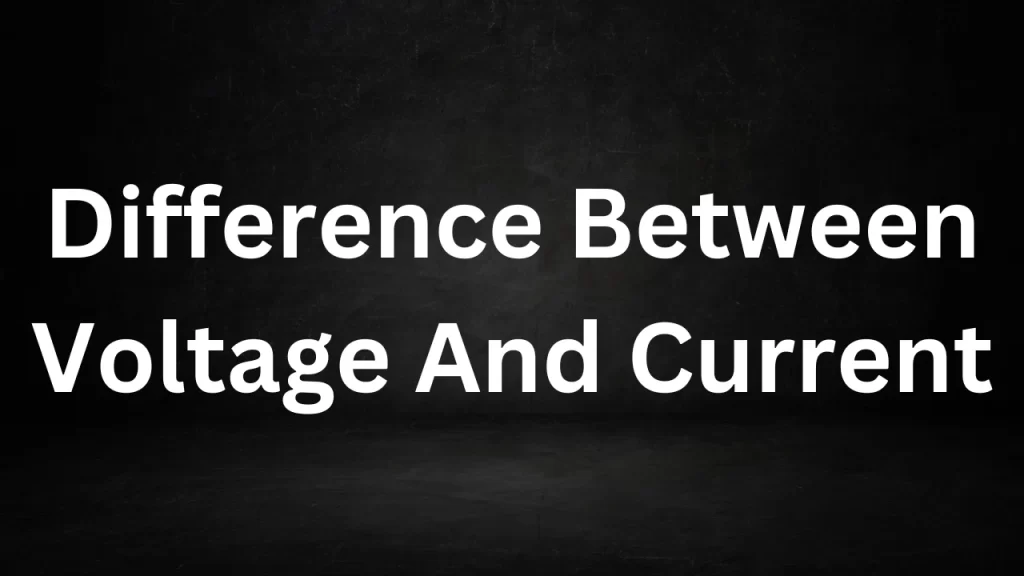
Difference Between Voltage And Current
1. Definition:
- Voltage: Volt, often referred to as electric potential difference, is the measure of electric potential energy per unit charge in an electric circuit. It is the force that drives electric charges (electrons) through a conductor. Voltage is measured in volts (V).
- Current: Current is the flow of electric charge in a circuit. It represents the rate at which electric charges (usually electrons) move through a conductor. Current is measured in amperes (A).
2. Symbol:
- Voltage: The symbol for voltage is “V.”
- Current: The symbol for current is “I.”
3. Unit:
- Voltage: Volt is measured in volts (V).
- Current: Current is measured in amperes (A).
4. Direction:
- Voltage: Volt is a scalar quantity, meaning it does not have a specific direction. It represents the electric potential difference between two points in a circuit.
- Current: Current is a vector quantity, meaning it has both magnitude and direction. It represents the flow of electric charge from one point to another in a specific direction.
5. Effect:
- Voltage: Voltage creates an electric field that exerts a force on electric charges, causing them to move in a certain direction. It provides the “push” or “pressure” that drives current.
- Current: Current is the actual flow of electric charges (usually electrons) through a conductor in response to the volt. It is the movement of these charges that constitutes an electric current.
6. Measurement Device:
- Voltage: Voltage is measured using a voltmeter, a device designed to measure the potential difference between two points in a circuit.
- Current: Current is measured using an ammeter, a device designed to measure the flow of electric charge in a circuit.
7. Example:
- Voltage: Imagine a water tank placed at a certain height above the ground. The height of the tank represents the volt. When a valve is opened, water (analogous to current) flows down from the tank due to the gravitational potential energy provided by the height (analogous to volt).
- Current: Think of the water flowing through a pipe. The rate at which water flows through the pipe is similar to electric current. The water pressure that pushes the water through the pipe is analogous to volt.
In summary, volt and current are distinct electrical parameters with different definitions, units of measurement, and effects in electrical circuits. Volt provides the potential energy that drives the flow of electric charges (current) through a conductor, and understanding both parameters is essential for comprehending the behavior of electrical systems and circuits.
Read More
- Difference Between Two Stroke And Four Stroke
- Difference Between Ac And Dc
- Changing The Period Of A Pendulum
- Electromagnetic Spectrum Radio Waves
- Behaviour Of Gas Molecules
Frequently Asked Questions (FAQs) Difference Between Voltage And Current
1. What is voltage, and how is it different from current?
Volt, measured in volts (V), represents the electric potential difference between two points in a circuit. It provides the force or pressure that drives the flow of electric charge (current) through a conductor.
2. What is current, and how does it relate to voltage?
Current, measured in amperes (A), is the flow of electric charge through a conductor. It is the result of volt applied to a circuit, as charges move in response to the electric field created by the volt.
3. Is voltage a scalar or vector quantity?
Volt is a scalar quantity, meaning it does not have a specific direction. It represents the electric potential difference between two points.
4. Is current a scalar or vector quantity?
Current is a vector quantity, meaning it has both magnitude and direction. It represents the flow of electric charge in a specific direction.
5. How do voltage and current interact in an electric circuit?
Volt provides the “push” or “pressure” that drives current through a conductor. In essence, volt creates an electric field that exerts a force on electric charges, causing them to move and establish a current.
Difference Between Two Stroke And Four Stroke
Difference Between Two Stroke And Four Stroke: Engines are the heart of machines that power our vehicles, equipment, and even some small appliances. Two-strokes and four-strokes engines are two common types used in various applications.
They differ in their design, operation, and performance characteristics. In this article, we will explore the key differences between two and four-strokes engines.
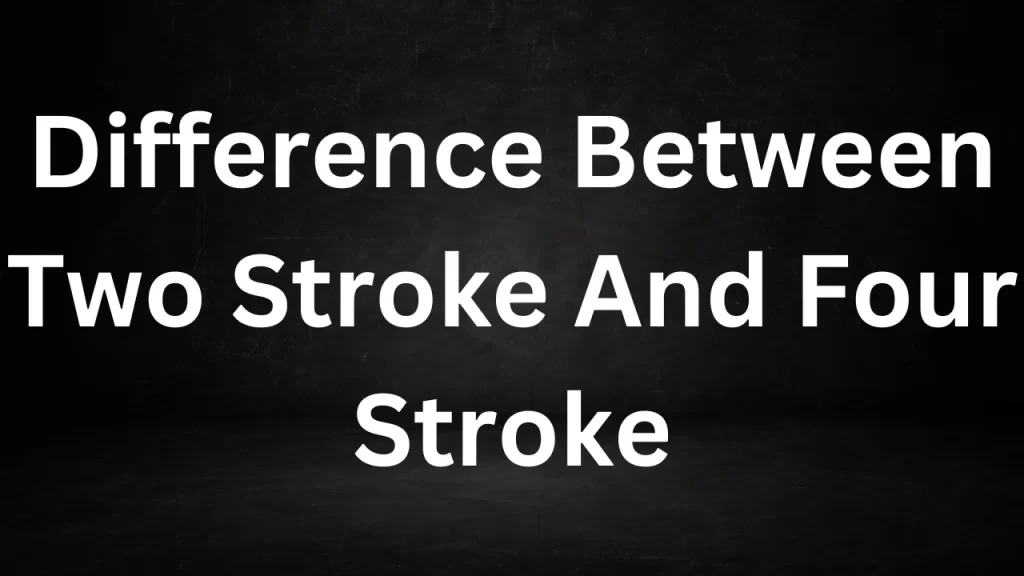
Difference Between Two Stroke And Four Stroke
1. Number of Strokes:
- Two-Stroke Engine: A two-strokes engine completes its cycle in two strokes of the piston—namely, the compression and power strokes. It combines the intake and exhaust processes in these two strokes.
- Four-Stroke Engine: A four-strokes engine completes its cycle in four strokes of the piston: intake, compression, power, and exhaust. Each strokes has a distinct function.
2. Operation:
- Two-Stroke Engine: In a two-strokes engine, the combustion process occurs every revolution of the crankshaft, making it produce power more frequently. This design tends to be simpler but less fuel-efficient.
- Four-Stroke Engine: In a four-strokes engine, the combustion process occurs every two revolutions of the crankshaft. It has a more structured cycle, leading to greater fuel efficiency and lower emissions.
3. Lubrication:
- Two-Stroke Engine: Two-strokes engines require oil to be mixed with the fuel for lubrication. This oil is burnt during combustion, leading to some emissions and a characteristic blue smoke.
- Four-Stroke Engine: Four-strokes engines have a separate oil reservoir for lubrication, which results in cleaner exhaust emissions.
4. Power Output:
- Two-Stroke Engine: Two-strokes engines are known for their higher power-to-weight ratio, making them suitable for applications where lightweight and compactness are essential.
- Four-Stroke Engine: Four-strokes engines tend to be more fuel-efficient and offer better torque characteristics. They are often used in applications where fuel efficiency is crucial.
5. Exhaust Emissions:
- Two-Stroke Engine: Two-strokes engines are less environmentally friendly due to the incomplete combustion of oil in the fuel mixture, resulting in higher emissions of hydrocarbons and particulate matter.
- Four-Stroke Engine: Four-strokes engines produce fewer emissions and are more compliant with emission regulations, making them a preferred choice in many applications.
6. Maintenance:
- Two-Strokes Engine: Two-strokes engines are relatively simpler in design, requiring less maintenance. However, they may require more frequent attention due to their higher wear rates.
- Four-Stroke Engine: Four-strokes engines have more complex designs and may require more maintenance, but they often have longer service intervals.
7. Applications:
- Two-Strokes Engine: Two-strokes engines are commonly used in applications where weight and simplicity are prioritized, such as small motorcycles, chainsaws, and certain recreational vehicles.
- Four-Strokes Engine: Four-strokes engines are prevalent in automobiles, trucks, larger motorcycles, generators, and many industrial and marine applications.
8. Fuel Efficiency:
- Two-Strokes Engine: Two-strokes engines are generally less fuel-efficient compared to four-strokes engines due to their frequent combustion cycles.
- Four-Strokes Engine: Four-strokes engines offer better fuel efficiency, making them suitable for vehicles and equipment where economy is a key consideration.
In conclusion, the choice between a two-strokes and a four-strokes engine depends on the specific requirements of the application. Two-strokes offer simplicity and higher power output in a lightweight package, while four-strokes provide better fuel efficiency, lower emissions, and durability, making them the preferred choice for many modern vehicles and equipment.
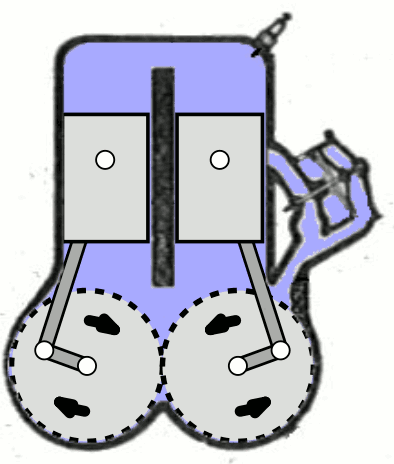
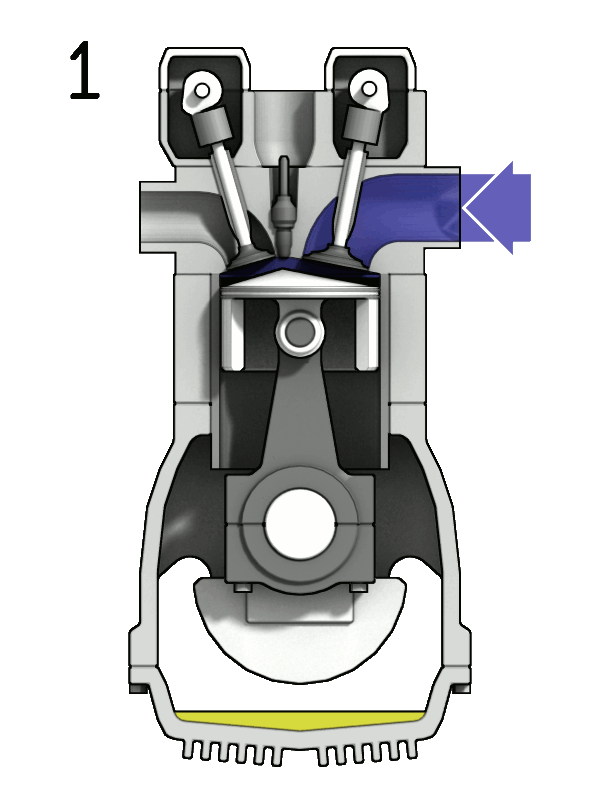
Read More
- Electromagnetic Spectrum Radio Waves
- Behaviour Of Gas Molecules
- Molar Mass Of Oxalic Acid
- Types Of Chemical Bonding
- Chemistry In Everyday Life
Frequently Asked Questions (FAQs) Difference Between Two Strokes And Four Strokes
1. What is the fundamental difference between a two-strokes and a four-strokes engine?
The primary difference lies in the number of strokes required to complete one engine cycle. A two-strokes engine completes a cycle in two strokes (compression and power), while a four-strokes engine completes it in four strokes (intake, compression, power, and exhaust).
2. Which engine type is more fuel-efficient, a two-strokes, or a four-strokes engine?
Generally, four-strokes engines are more fuel-efficient than two-strokes engines. Four-strokes have a more structured combustion cycle, leading to better fuel economy.
3. Are two-strokes engines more powerful than four-strokes engines?
Two-strokes engines often have a higher power-to-weight ratio and can produce more power per unit of displacement. However, four-strokes engines can offer better torque characteristics and efficiency.
4. Do two-strokes engines require mixing oil with fuel for lubrication?
Yes, two-strokes engines require oil to be mixed with the fuel to provide lubrication. This oil is burned during combustion, leading to characteristic blue exhaust smoke.
5. Which type of engine produces fewer emissions, two-strokes, or four-strokes
Four-strokes engines generally produce fewer emissions and are more environmentally friendly due to their cleaner combustion process.
Difference Between Ac And Dc
Difference Between Ac And Dc: AC (Alternating Current) and DC (Direct Current) are two fundamental types of electric currents with distinct characteristics and applications.
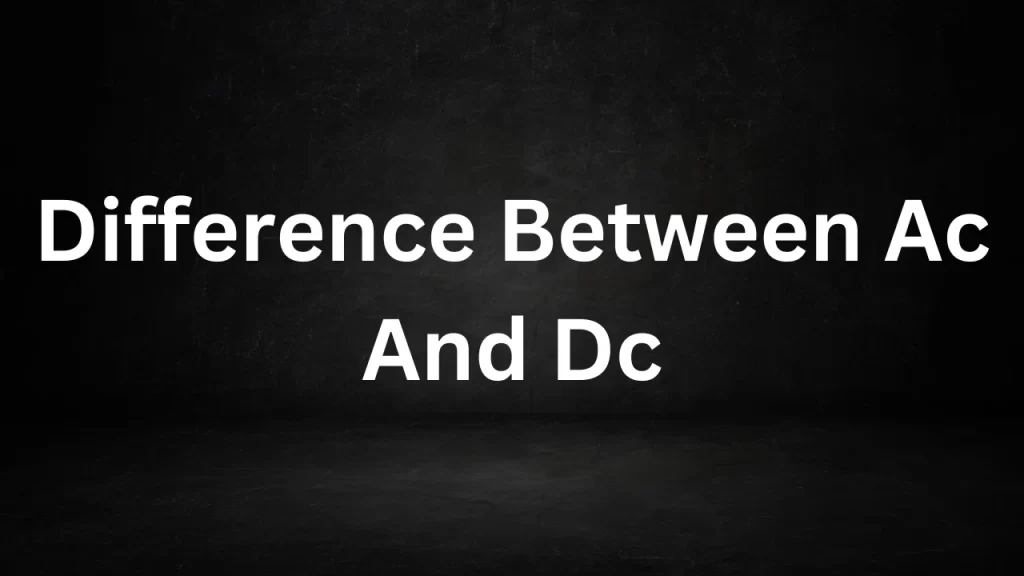
Difference Between Ac And Dc
1. Direction of Current:
- AC (Alternating Current): In AC, the direction of current flow periodically reverses, meaning it alternates between a positive and negative direction. This reversal occurs at a specific frequency, typically measured in Hertz (Hz). AC is represented by sinusoidal waveforms.
- DC (Direct Current): In DC, the current flows steadily in one direction, maintaining a constant polarity. There is no reversal or oscillation in the direction of current flow.
2. Voltage Polarity:
- AC: AC voltage alternates between positive and negative values in a cyclical manner, creating a continuously changing voltage polarity.
- DC: DC voltage remains constant with a fixed polarity, either positive or negative, depending on the direction of current flow.
3. Sources of AC and DC:
- AC: AC is commonly generated by alternating current generators (alternators) and is the type of electricity distributed in most homes and businesses worldwide.
- DC: DC is typically generated by batteries, solar cells, fuel cells, and rectifiers, which convert AC to DC.
4. Energy Transmission:
- AC: AC is well-suited for long-distance energy transmission over power lines. It can be easily transformed to higher or lower voltages using transformers, reducing energy losses during transmission.
- DC: DC transmission is used for certain applications, such as high-voltage direct current (HVDC) power lines, where long-distance transmission with minimal losses is required.
5. Electrical Devices and Appliances:
- AC: Most household electrical devices and appliances operate on AC power. AC is versatile and compatible with various types of equipment.
- DC: Certain devices and applications, such as electronic gadgets, computers, and some vehicle components, operate on DC power. These devices typically require internal conversion from AC to DC.
6. Electromagnetic Compatibility:
- AC: AC systems can produce electromagnetic interference (EMI) due to the rapid changes in voltage and current direction. EMI can affect nearby electronic equipment.
- DC: DC systems may generate less EMI, making them suitable for sensitive electronic applications.
7. Safety Considerations:
- AC: AC systems are generally considered more dangerous to humans in terms of electric shock. The rapid changes in voltage can be more likely to disrupt heart rhythms.
- DC: DC is often considered safer for low-voltage systems, as it has a more stable voltage. However, high-voltage DC can still pose risks.
8. Historical Significance:
- AC: AC power distribution, popularized by Nikola Tesla and George Westinghouse, revolutionized electrical engineering and became the standard for power transmission in the late 19th century.
- DC: DC power was historically used by Thomas Edison for early electric lighting systems, but it was largely supplanted by AC for long-distance power transmission.
In summary, AC and DC are two distinct types of electric currents with different characteristics and applications. AC is characterized by alternating current direction and voltage polarity, making it suitable for power distribution, while DC has a constant current direction and voltage polarity, making it essential for many electronic devices and specific transmission applications.
Read More
- Changing The Period Of A Pendulum
- Electromagnetic Spectrum Radio Waves
- Behaviour Of Gas Molecules
- Molar Mass Of Oxalic Acid
- Types Of Chemical Bonding
Frequently Asked Question (FAQs) Difference Between Ac And Dc
What is AC (Alternating Current) and DC (Direct Current)?
- AC (Alternating Current): AC is a type of electric current in which the direction of flow periodically reverses, resulting in an oscillating voltage and current. It is represented by sinusoidal waveforms.
- DC (Direct Current): DC is a type of electric current that flows steadily in one direction, maintaining a constant voltage polarity. There is no reversal of current direction.
Which one is more commonly used for electrical power distribution in homes and businesses?
AC is the most commonly used type of current for electrical power distribution in homes and businesses worldwide. It is generated at power plants and transmitted over long distances to provide electricity to consumers.
How is AC generated?
AC is typically generated by alternating current generators (alternators). These devices use mechanical energy, often from turbines or engines, to produce AC electricity.
How is DC generated?
DC can be generated using various methods, including batteries, solar cells, fuel cells, and rectifiers, which convert AC to DC.
Why is AC preferred for long-distance power transmission?
AC is preferred for long-distance power transmission because it can be easily transformed to higher or lower voltages using transformers. This transformation reduces energy losses during transmission.
Changing The Period Of A Pendulum
Changing The Period Of A Pendulum: A pendulum is a simple yet fascinating mechanical system with a swinging weight or bob attached to a string or rod.

Changing The Period Of A Pendulum
Factors That Affect the Period of a Pendulum:
Length of the String or Rod: The most influential factor in determining a pendulum’s period is the length of its string or rod. Longer pendulums typically have longer periods, meaning they take more time to swing back and forth. This relationship is expressed by the formula for the period of a simple pendulum:
T = 2π√(L/g)
Where:
- T is the period of the pendulum.
- L is the length of the string or rod.
- g is the acceleration due to gravity (approximately 9.81 m/s² on Earth).
This equation shows that the period (T) is directly proportional to the square root of the length (L). Therefore, increasing the length of the pendulum will result in a longer period.
Acceleration Due to Gravity: The local gravitational field strength (g) affects the period of a pendulum. If you were on a celestial body with a different gravitational field strength, the period of the pendulum would change accordingly. On Earth, the standard gravitational field strength is approximately 9.81 m/s².
Effects of Changing the Period of a Pendulum:
Timekeeping: Pendulums have been historically used in various timekeeping devices, such as pendulum clocks. By adjusting the length of the pendulum, clockmakers could fine-tune the clock’s accuracy. Longer pendulums result in slower, more accurate timekeeping.
Physics Experiments: In physics experiments and demonstrations, altering the period of a pendulum can be used to study various principles, including harmonic motion and energy conservation.
Art and Installations: Artists and engineers often incorporate pendulums into their creations, creating mesmerizing kinetic sculptures. By adjusting the pendulum’s length, they can control the visual and auditory effects of their artworks.
Seismology: In seismology, pendulums are used in seismometers to detect and measure ground motion during earthquakes. The period of the pendulum in a seismometer can be adjusted to match the expected frequencies of seismic waves.
Education: Pendulums are valuable tools for teaching physics concepts to students. By manipulating the length of a pendulum, educators can demonstrate principles of physics and mathematics in a hands-on manner.
In conclusion, the period of a pendulum is influenced primarily by its length and the local acceleration due to gravity.
Read More
- Electromagnetic Spectrum Radio Waves
- Behaviour Of Gas Molecules
- Molar Mass Of Oxalic Acid
- Types Of Chemical Bonding
- Chemistry In Everyday Life
Frequently Asked Question (FAQs) Changing The Period Of A Pendulum
What is the period of a pendulum?
The period of a pendulum is the time it takes for the pendulum to complete one full oscillation, which includes swinging from one extreme point to the other and back.
What factors can change the period of a pendulum?
Two primary factors that can change the period of a pendulum are:
- The length of the string or rod: Longer pendulums have longer periods.
- The local acceleration due to gravity: Different gravitational field strengths will result in different periods for the same pendulum length.
How does the length of a pendulum affect its period?
The length of a pendulum has a direct impact on its period. Specifically, the period (T) is directly proportional to the square root of the length (L). This means that increasing the length of the pendulum will result in a longer period, and vice versa.
What is the formula for calculating the period of a simple pendulum?
The formula for the period (T) of a simple pendulum is:
T = 2π√(L/g)
Where:
- T is the period of the pendulum.
- L is the length of the string or rod.
- g is the acceleration due to gravity.
Can the period of a pendulum be adjusted for specific applications?
Yes, the period of a pendulum can be adjusted by changing its length. Clockmakers, scientists, and artists often adjust the length of pendulums to suit their specific needs, such as accurate timekeeping, physics experiments, or artistic installations.
Electromagnetic Spectrum Radio Waves
Electromagnetic Spectrum Radio Waves: The electromagnetic spectrum is a vast continuum of energy waves, each with different frequencies and wavelengths.
Radio waves constitute one significant segment of this spectrum, playing a crucial role in modern technology and communication. In this article, we will delve into the world of radio waves, exploring their properties, applications, and significance in our daily lives.
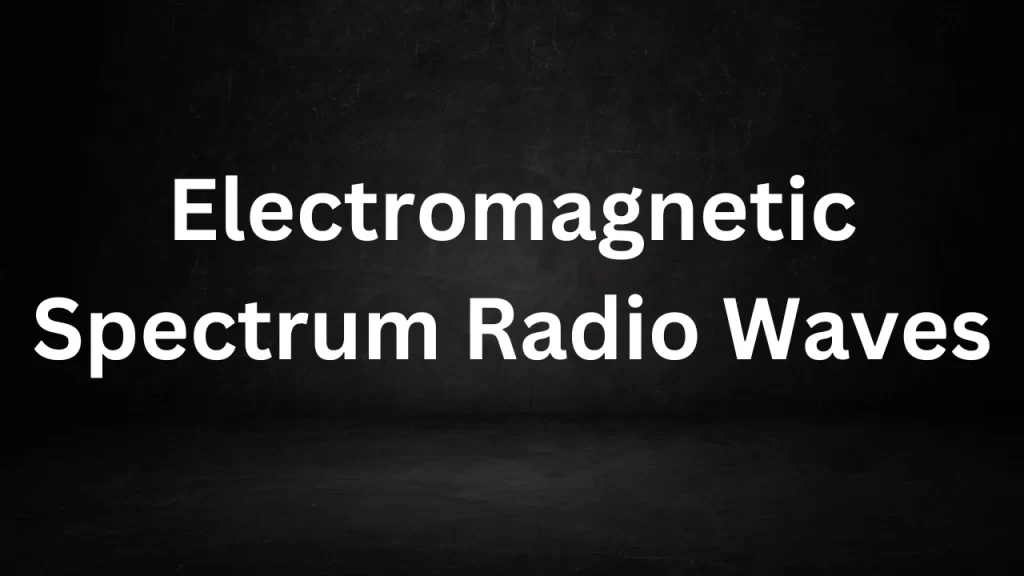
Electromagnetic Spectrum Radio Waves
Properties of Radio Waves:
Wavelength: Radio waves have wavelengths ranging from several millimeters to thousands of kilometers. Due to their long wavelengths, they can diffract (bend) around obstacles and follow the curvature of the Earth, enabling long-distance communication.
Frequency: Radio waves have frequencies ranging from about 3 kHz (kilohertz) to 300 GHz (gigahertz). They cover a broad spectrum within this range, allowing for various applications.
Speed: Like all electromagnetic waves, radio waves travel at the speed of light in a vacuum, which is approximately 299,792,458 meters per second (about 186,282 miles per second).
Applications of Radio Waves:
Wireless Communication: Radio waves are the foundation of wireless communication technologies, including radio broadcasting, television broadcasting, cell phones, Wi-Fi, and satellite communication. They enable the transmission of audio, video, data, and voice over long distances.
Radar Systems: Radar (Radio Detection and Ranging) systems use radio waves to detect and track objects, such as aircraft, ships, and weather patterns. They are vital in aviation, navigation, weather forecasting, and military applications.
Radio Astronomy: Radio telescopes detect radio waves from celestial objects, allowing astronomers to study objects in space that emit radio frequency radiation. This field has led to discoveries like pulsars and quasars.
Remote Sensing: Radio waves are used in remote sensing applications, including weather radar, Earth observation satellites, and environmental monitoring. They help gather data on weather patterns, climate change, and natural disasters.
RFID Technology: Radio-frequency identification (RFID) technology uses radio waves to identify and track objects. It is commonly used in inventory management, access control systems, and contactless payment methods.
Medical Imaging: Magnetic resonance imaging (MRI) machines use radio waves to create detailed images of the human body’s internal structures, providing valuable diagnostic information in medicine.
Safety Considerations:
While radio waves are generally safe, excessive exposure to high-intensity radiofrequency radiation can lead to localized heating effects in tissues. As a result, regulatory agencies around the world have established safety guidelines to limit human exposure to radiofrequency radiation from devices like cell phones and microwave ovens.
In conclusion, radio waves are a fundamental and versatile component of the electromagnetic spectrum, playing a crucial role in modern technology, communication, and scientific research. Their long wavelengths and wide range of applications have revolutionized the way we connect, explore the cosmos, and interact with our environment. Radio waves continue to shape the future of technology and our ability to communicate across the globe.
Read More
- Behaviour Of Gas Molecules
- Molar Mass Of Oxalic Acid
- Types Of Chemical Bonding
- Chemistry In Everyday Life
- Energy Stored In A Capacitor
Frequently Asked Question (FAQs) Electromagnetic Spectrum Radio Waves
What are radio waves in the electromagnetic spectrum?
Radio waves are a type of electromagnetic radiation characterized by their long wavelengths and low frequencies. They are a fundamental part of the electromagnetic spectrum, which also includes visible light, microwaves, and X-rays.
How do radio waves differ from other types of electromagnetic waves?
Radio waves have longer wavelengths and lower frequencies compared to other types of electromagnetic waves, such as microwaves, infrared, visible light, ultraviolet, X-rays, and gamma rays. This distinction in wavelength and frequency leads to unique properties and applications.
What are the practical applications of radio waves?
Radio waves have a wide range of applications, including wireless communication (e.g., radio, television, cell phones), radar systems, radio astronomy, remote sensing, RFID technology, medical imaging (MRI), and more.
How do radio waves enable wireless communication?
Radio waves are used to transmit audio, video, data, and voice signals wirelessly. Devices like radios, cell phones, and Wi-Fi routers emit and receive radio waves, allowing for long-distance communication without physical connections.
What is the speed at which radio waves travel?
Radio waves, like all electromagnetic waves, travel at the speed of light in a vacuum, which is approximately 299,792,458 meters per second (about 186,282 miles per second).
Behaviour Of Gas Molecules
Behaviour Of Gas Molecules: The behavior of gas molecules is a fascinating topic in the realm of physics and chemistry.
To comprehend how gases behave under various conditions, scientists have developed the Kinetic Theory of Gases, which provides valuable insights into the movement, interactions, and properties of gas molecules.

Behaviour Of Gas Molecules
Key Assumptions of the Kinetic Theory of Gases:
- Gas Molecules are in Constant Motion: According to the kinetic theory, gas molecules are in a continuous state of motion. They move randomly and rapidly in all directions, colliding with each other and the walls of their container.
- Negligible Volume and Particle Size: Gas molecules are considered to have negligible volume compared to the total volume of the gas and are treated as point particles. The distances between gas molecules are relatively large compared to their sizes.
- Elastic Collisions: Gas molecules undergo perfectly elastic collisions with each other and the walls of the container. In an elastic collision, both kinetic energy and momentum are conserved.
- No Interactions Except During Collisions: Gas molecules do not exert attractive or repulsive forces on each other except during collisions. This is in contrast to liquids and solids, where intermolecular forces play a significant role.
- Average Kinetic Energy is Proportional to Temperature: The kinetic energy of gas molecules is directly proportional to the absolute temperature (in Kelvin) of the gas. This relationship is described by the equation:Where:
- is the average kinetic energy of gas molecules.
- is the Boltzmann constant.
- is the absolute temperature in Kelvin.
Consequences of the Kinetic Theory:
- Pressure: The pressure exerted by a gas on the walls of its container is a result of the constant collisions of gas molecules with those walls. More frequent and forceful collisions result in higher pressure.
- Temperature and Kinetic Energy: As the temperature of a gas increases, the average kinetic energy of its molecules also increases. This leads to faster molecular motion and more energetic collisions.
- Volume and Molecular Density: Changes in volume affect the density of gas molecules. If the volume of a gas is decreased while keeping the number of molecules constant (as in compression), the density of gas molecules increases, leading to higher pressure.
- Diffusion and Effusion: Gas molecules move from areas of high concentration to low concentration through diffusion. Effusion is the process by which gas molecules escape through a small opening. Both processes are explained by the random motion of gas molecules.
- Gas Laws: The kinetic theory provides a theoretical foundation for various gas laws, including Boyle’s Law, Charles’s Law, and Avogadro’s Law, which describe the relationships between pressure, volume, temperature, and the number of gas molecules.
In conclusion, the behavior of gas molecules is governed by the principles of the Kinetic Theory of Gases. Understanding this theory allows scientists and engineers to make predictions about the properties and behavior of gases under different conditions, which is essential in fields ranging from chemistry and physics to engineering and atmospheric science.
Read More
- Molar Mass Of Oxalic Acid
- Types Of Chemical Bonding
- Chemistry In Everyday Life
- Energy Stored In A Capacitor
- Compound Lenses Thin Lenses In Contact
Frequently Asked Question (FAQs) Behaviour Of Gas Molecules
-
What is the Kinetic Theory of Gases?
The Kinetic Theory of Gases is a scientific model that describes the behavior of gas molecules. It is based on several key assumptions, including that gas molecules are in constant motion, have negligible volume and particle size, undergo elastic collisions, and have average kinetic energy proportional to temperature.
-
What is the significance of gas molecules being in constant motion?
The constant motion of gas molecules explains many macroscopic properties of gases, such as pressure, temperature, and volume. It helps us understand how gases fill containers, exert pressure on their surroundings, and diffuse or mix with other gases.
-
How do gas molecules exert pressure?
Gas molecules exert pressure by colliding with the walls of their container. The force of these collisions per unit area is what we perceive as gas pressure. An increase in the frequency or force of collisions leads to higher pressure.
-
Why do gas molecules have negligible volume and size in the Kinetic Theory?
Considering gas molecules as having negligible volume and size simplifies calculations and is a reasonable approximation because the distances between gas molecules are much larger than their sizes.
-
What is an elastic collision, and why is it important in the Kinetic Theory of Gases?
An elastic collision is a collision in which both kinetic energy and momentum are conserved. In the context of the Kinetic Theory, elastic collisions between gas molecules and container walls help explain how gases exert pressure and how energy is transferred within the gas.